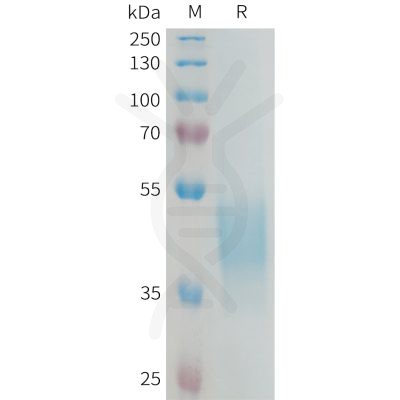| TARGET | |
|---|---|
| SYNONYMS |
p58;NKAT;GL183;NKAT2;CD158b;KIR2DL;NKAT2A;NKAT2B;CD158B2;KIR-K7b;KIR-K7c;KIR2DS5;KIRCL23;KIR-023GB |
| DESCRIPTION |
Recombinant Human KIR2DL3 Protein with C-terminal 6XHis tag |
| DELIVERY |
In Stock |
| UNIPROT ID |
P43628 |
| EXPRESSION HOST |
HEK293 |
| TAG |
C-6×His Tag |
| MOLECULAR CHARACTERIZATION |
KIR2DL3(His22-His245) 6×His tag |
| MOLECULAR WEIGHT |
The protein has a predicted molecular mass of 25.4 kDa after removal of the signal peptide. The apparent molecular mass of KIR2DL3-His is approximately 35-55 kDa due to glycosylation. |
| PURITY |
The purity of the protein is greater than 85% as determined by SDS-PAGE and Coomassie blue staining. |
| FORMULATION & RECONSTITUTION |
Lyophilized from sterile PBS, pH 7.4. Normally 5 % – 8% trehalose is added as protectants before lyophilization. Please see Certificate of Analysis for specific instructions of reconstitution. |
| STORAGE & SHIPPING |
Store at -20°C to -80°C for 12 months in lyophilized form. After reconstitution, if not intended for use within a month, aliquot and store at -80°C (Avoid repeated freezing and thawing). Lyophilized proteins are shipped at ambient temperature. |
| BACKGROUND |
Killer cell immunoglobulin-like receptors (KIRs) are transmembrane glycoproteins expressed by natural killer cells and subsets of T cells. The KIR genes are polymorphic and highly homologous and they are found in a cluster on chromosome 19q13.4 within the 1 Mb leukocyte receptor complex (LRC). The gene content of the KIR gene cluster varies among haplotypes, although several "framework" genes are found in all haplotypes (KIR3DL3, KIR3DP1, KIR3DL4, KIR3DL2). The KIR proteins are classified by the number of extracellular immunoglobulin domains (2D or 3D) and by whether they have a long (L) or short (S) cytoplasmic domain. KIR proteins with the long cytoplasmic domain transduce inhibitory signals upon ligand binding via an immune tyrosine-based inhibitory motif (ITIM), while KIR proteins with the short cytoplasmic domain lack the ITIM motif and instead associate with the TYRO protein tyrosine kinase binding protein to transduce activating signals. The ligands for several KIR proteins are subsets of HLA class I molecules; thus, KIR proteins are thought to play an important role in regulation of the immune response. [provided by RefSeq, Jul 2008] |
| USAGE |
Research use only |
1
/
의
1
Dima Biotech
SKU(재고 관리 코드):PME100319
Human KIR2DL3 Protein, His Tag
Human KIR2DL3 Protein, His Tag
PRODUCT DATA
IMAGES

Figure 1.Human KIR2DL3 Protein, His Tag on SDS-PAGE under reducing condition.
Share


